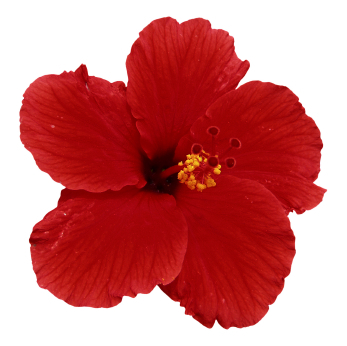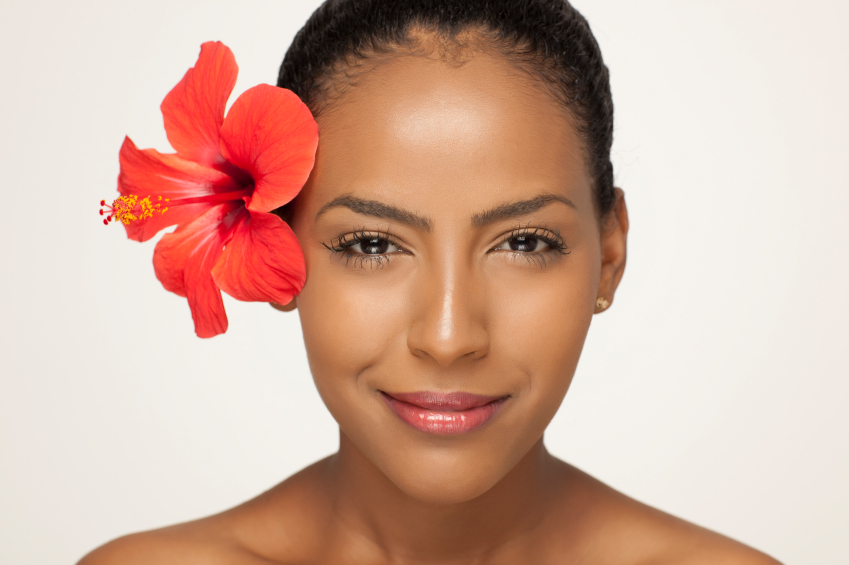Hibiscus powder (aka Jaswand/Jaswandi) comes from the crushed flower petals of the Hibiscus plant, Hibiscus sabdariffa. Hibiscus makes an excellent cooling and tasty beverage, and is an even better addition to natural hair and skin care! We’re also pleased to announced that by the end of February, Henna Sooq will have a new shipment of hibiscus that will be 100% organic.
For the hair, hibiscus is a gentle cleanser (slightly on the acidic side of neutral), and a conditioning herb that helps decrease hair shedding by strengthening and conditioning the roots, increases shine, creates volume, adds a reddish tint to the hair (more prominent on lighter hair), promotes hair growth, and helps with scalp disorders. It is also great as a gentle scalp scrub.
How to use Hibiscus powder:
There are many ways one can use Hibiscus powder: Alone, as a tea rinse, infused in a carrier oil, in henna to boost red tones, in conditioner, with other ayurvedic herbs, in coconut milk or yogurt, infused in vinegar and used as the final rinse, as the tea base for henna, a scalp scrub, with Rhassoul mud and as a face masque. Those with lighter hair should use Hibiscus with caution as it may stain the hair temporarily.
Using Hibiscus on its own:
An all-round fantastic treatment for all hair types. Caution to those that have lighter hair as Hibiscus may stain.
Mix enough Hibiscus powder with water or tea and apply to damp clean hair. Cover and let sit for a couple of hours. Add 1 tsp of any oil of your choice, yoghurt, or coconut milk for extra conditioning.
Hibiscus as a cleanser alone:
Just as above, make a paste with Hibiscus and gently massage into the hair. Leave on for 5-10 minutes and wash off. Hibiscus isn’t as strong as say Shikakai or Aritha when it comes to removing oil treatments from the hair. Combining Hibiscus with these herbs ensure that the excess oil will be washed away. Hibiscus is a gentle cleanser.
Hibiscus as a post-wash rinse: (Great for shine).
Scoop in 2-4 tablespoons of Hibiscus powder into 2-3 cups of almost boiling water. Steep for 20 minutes or until warm to the touch and strain the liquid. After you’ve finished washing, pour the tea over your hair and let it sit for a few minutes. Rinse with water if you wish.
Infusing carrier oils with Hibiscus
This changes the colour of the carrier oil.
Method 1 (slow):
In a jar, add half a cup of carrier oil (coconut, olive, sweet almond, avocado, apricot kernel oil, hemp seed oil, camellia, grapeseed, etc), add 2 tablespoons of Hibiscus powder, replace the jars lid and shake. Leave in a dark place for 2-4 weeks shaking the jar every day. The oil can be strained, but it doesn’t need to be!
Method 2 (fast).
Use the same amounts as method one, but add the oil and Hibiscus powder to a small saucepan and gently heat on the stove for 30 minutes on low heat. Jar strained or unstrained.
Adding Hibiscus to Henna to boost red tones:
Mix 1-4 tablespoons of Hibiscus powder in with the henna powder before adding any liquids. This assures that the Hibiscus is less gritty. Apply to damp, clean hair. A tea can also be made and used as the liquid component of the henna treatment.
Hibiscus with other ayurvedic herbs:
Add 1-4 tablespoons to a herb pack before adding liquids. Hibiscus tea can also be used as the liquid instead of water. For those that make teas to wash with, add 1-2 tablespoons of Hibiscus to the water (or use instead of water) when adding the other herbs, let sit, then strain. Pour tea over hair, cover and let sit for 10 or so minutes.
Hibiscus vinegar infusion (as a final rinse)
Add 2-4 tablespoons of Hibiscus to half a cup of apple cider vinegar and let steep for at least 2 weeks in a dark area, shaking the jar every day. Use 1-2 tablespoons of the vinegar to 2-3 cups of water as the final rinse after washing the hair. Over time, this rinse will help brighten red tones. Use white vinegar instead of Apple cider for less colour. If you have lighter hair, please test this on shed hair balls to see if there is any colour change.
Adding Hibiscus to Rhassoul/coconut milk/yoghurt/flax seed gel/conditioner:
Add 1-3 tablespoons of powder to any of the above and let sit for 15 minutes. Apply to damp clean hair, cover and leave on for a couple of hours. Rinse well. This method may be best for those with lighter hair. The coconut milk and yoghurt mixture is great for dryer/coarser hair.
Each of the above recipes (except the henna, conditioner and vinegar infusion) can be adapted for facial masques/body scrubs as well. Hibiscus tea can also be used as a toner as well as a base to moisten the dry ingredients. As a facial body scrub, mix hibiscus with water and let sit for 15 minutes. Add some honey (or any other natural syrup such as molasses (for darker hair) or agave) if you’re allergic to honey) and scrub the face/body. The addition of rhassoul would boost the cleansing power.
Other additions:
Egg yolk (avoid the albumen/whites as it can be drying), avocado (blended until smooth, great for deep moisture), banana (blended until smooth, also great for moisture), butters like shea and cocoa butter for dry coarse hair, other teas such as chamomile, kitchen herbs such as rosemary, sage, basil and mints. Aloe vera gel and glycerin can also be added for those ‘rainy day’ treatments.
Remember, experimenting is part of the fun. Adding essential oils or even combining treatments can be done as well!



















I’m really excited about using the Hibiscus powder! I just order some, along with the Red Raj. Thank you for the note about adding the powder to henna BEFORE adding the liquid!
I just ordered some hibiscus too, and am very excited to try it with my Yemeni henna! I was wondering how to store the hibiscus…should I store it in the freezer like the henna? Or just room temp? Also, if I make a pre-made henna mixture can I freeze it WITH the hibiscus in it? Thank you!
Amber, you’re very welcome! Hibiscus can also be mixed alone, then added to dye released henna.
Julie, Hibiscus is best kept in the freezer for ultimate freshness. 🙂
Thank you! 😀
Hey hi Vanessa 🙂 hope you’re doing well! Am really in awe of hibiscus since a few weeks now so now am planning 2 incorporate it into my hair care regimen 🙂 Since I use a homemade hair pack comprising of “Aloe vera,hibiscus,fenugreek powder”(as a shampoo-recently heard about the NO POO MOVEMENT”,so can I substitute the above mentioned “coconut milk+ hibiscus”as my conditioner?
My Hibiscus came in with my Red Raj today!! I’ll be mixing it all up tonight and putting it in the mixer and applying it in the morning!! I’ve also discovered that putting oil on my hair before I apply it all will keep it from being so dry!! I had weight loss surgery 5 1/2 months ago and my hair is falling out!! All of this should help!! Thanks for all the wonderful info!!
Can hibiscus be used to boost reds with Red Raj for body art as well? Would a 2:1 henna to hibiscus mix be used for that as well, or a different ratio? I’d like to create cherry reds as much as possible for art on wrists and the backs of hands… and then use a different mix that is as dark as possible as well… trying to get the look of reds and blacks on skin.
Also, separate but related question: any idea how vanilla powder (or extract) added to Red Raj (with or without hibiscus) would affect henna on hair and/or skin? I don’t like the smell of most essential oils, and am looking to offset the hay smell of the henna.
Hi Janie. Thank you for your post on our blog. No unfortunately hibiscus can’t boost red tones of Red Raj for skin. It only works for hair. Have you already used Red Raj to get those tones? Sometimes adding jamila helps bring out more red, or even just using straight moroccan henna. Other aspects that play a role in the color results is also skin chemistry.
For skin again other herbs won’t help the Red Raj but reduce the color results. If you use it for hair it should be fine, except this would dilute some of the color for hair too. I hope this helps
I henna weekly on my roots. I see you say that hibiscus is slightly acidic, so is it going to be drying on my hair/scalp to mix it into my henna mix weekly?? I mean, is it like lemon juice, no, right?
Hello Andrea. It shouldn’t be any more drying then usual. It doesn’t replace lemon juice but you also don’t have to use lemon juice as your main liquid. I hope this helps.
i would like to know can hibiscus mixed with socked water of sea bird nest for washing hair?
Can I mix hibiscus powder with a carrier oil and apply it to my hair and leave it for a few hours then wash it off with water and regular shampoo and conditioner? What effects will it have on my hair? Thanks.
y.
I have many types of carrier oils to choose from; olive oil, coconut oil, almond oil, rice bran oil,apricot oil, hemp oil, castor oil. Would each one work differently with the hibiscus?
Would mixing in an essential oil help also. I have a variety. I’ll be here a while trying to remember them all, but which would be the best to use with the powder?
Hello Amanda. Yes absolutely. You can do so to achieve the benefits from hibiscus powder as found here: http://www.hennasooq.com/organic-hibiscus-petal-powder/
None of those oils will work differently for the hibiscus but based on your hair type. I’d really recommend the hair oil or blend of oils that works best for your hair type. Essential oils do have hair benefits and they too vary. I’d really recommend you view through our lemongrass, lavender, clary sage, or rosemary. All oils that work for your own hair type with with all of our ayurvedic powders 🙂
Hi!
Can I use henna & hibiscus mixture (2:1) which I further mix with indigo? I colour my hair dark brown as such always use indigo.
Does hibiscus change my black hair to brown if I apply on my hair. Plz let me know this. Thanks in advance.
Hi Joyce. If you use hibiscus by itself it won’t change the color of your dark colored hair at all. Even if you chose to use henna, natural herbs don’t lighten the hair. You would need chemicals to do so. Be wary of any henna products that claim to lighten the hair, and if they do read the ingredients to see what truly is lightening your hair.
About how long does hibiscus last in the hair when used alone as a mask? How long should i leave it in my hair for when its applied alone? Also does it last longer in the hair when mixed with henna?
Adding hibiscus alone won’t make such a color change on it’s own. Which henna did you use from us? What is the end color result you’d like to achieve?